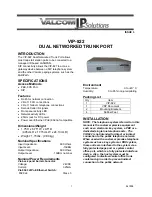
1-12
In queue scheduling, SP sends packets in the queue with higher priority strictly following the priority
order from high to low. When the queue with higher priority is empty, packets in the queue with lower
priority are sent. You can put critical service packets into the queues with higher priority and put
non-critical service (such as e-mail) packets into the queues with lower priority. In this case, critical
service packets are sent preferentially and non-critical service packets are sent when critical service
groups are not sent.
The disadvantage of SP queue is that: if there are packets in the queues with higher priority for a long
time in congestion, the packets in the queues with lower priority will be “starved” because they are not
served.
2) WRR
queuing
Figure 1-8
Diagram for WRR queuing
WRR queue-scheduling algorithm schedules all the queues in turn and every queue can be assured of
a certain service time. Assume there are four output queues on a port. WRR configures a weight value
for each queue, which is w3, w2, w1, and w0 for queue 3 through queue 0. The weight value indicates
the proportion of obtaining resources. On a 100 M port, configure the weight value of WRR
queue-scheduling algorithm to 5, 3, 1, and 1 (corresponding to w3, w2, w1, and w0 in order). In this way,
the queue with the lowest priority can get 10 Mbps bandwidth (100-Mbps × 1/ (5 + 3 + 1 + 1)) at least,
and the disadvantage of SP queue-scheduling that the packets in queues with lower priority may not get
service for a long time is avoided. Another advantage of WRR queue is that: though the queues are
scheduled in order, the service time for each queue is not fixed; that is to say, if a queue is empty, the
next queue will be scheduled. In this way, the bandwidth resources are made full use.
3) HQ-WRR
queuing
HQ-WRR is an improvement over WRR. Assume there are four priority queues on a port and queue 3
allocated with the highest priority, the switch will ensure that this queue get served first and will perform
round-robin scheduling to the other three queues when the traffic has exceeded the bandwidth capacity
of a port.
Flow-Based Traffic Accounting
The function of traffic-based traffic accounting is to use ACL rules in traffic classification and perform
traffic accounting on the packets matching the ACL rules. You can get the statistics of the packets you
are interested in through this function.
Содержание S3100 Series
Страница 12: ...10 You can e mail your comments about product documentation to info h3c com We appreciate your comments...
Страница 74: ...7 7 Sysname ip http acl 2030...
Страница 270: ...1 51 Sysname GigabitEthernet1 0 1 port trunk permit vlan all...
Страница 287: ...1 14 the interface on which the packet actually arrived The RPF check succeeds and the packet is forwarded...
Страница 579: ...ii Configuration Example 2 4 QoS Profile Configuration Example 2 4...
Страница 713: ...1 22 Total associations 1...
Страница 823: ...1 16...
Страница 1054: ...i Table of Contents Appendix A Acronyms A 1...
















































